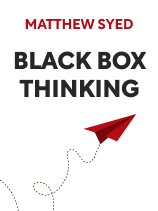

This article is an excerpt from the Shortform book guide to "Black Box Thinking" by Matthew Syed. Shortform has the world's best summaries and analyses of books you should be reading.
Like this article? Sign up for a free trial here .
What is a growth mindset culture? How do you create a growth mindset culture?
A growth mindset culture is established when individuals make mistakes and then learn from those mistakes, rather than ignoring them. A growth mindset culture believes that failure is expected and that failure should be a tool for learning.
Read more to understand the concept of a growth mindset culture and how to create one.
Creating a Growth Mindset Culture
According to Syed, creating individuals and organizations that learn from their mistakes starts with changing how we think about failure. By reframing failure as positive and beneficial, we can overcome the fear of erring and start learning from mistakes in our lives and our organizations. This creates a growth mindset culture.
To explain why changing your view of failure is the key, Syed refers to psychologist Carol Dweck’s ideas of “growth mindset” versus “fixed mindset”:
- People with a fixed mindset believe that ability is set in stone—in other words, you’re good at some things and bad at others, and you can’t change that.
- People within a growth mindset culture believe that ability develops through practice—put another way, you grow by taking action, messing up, and trying again.
(Shortform note: Whether you have a growth or fixed mindset isn’t all-or-nothing, and it can vary from domain to domain. For example, someone who becomes physically fit through trial-and-error might believe that the same approach wouldn’t work with mathematics or science. In this way, we often kneecap our growth in some areas of life even while growing in others. To avoid this, try taking your growth mindset from a strength of yours and applying it to weaker areas of your life—such as extending your skill in business thinking to emotional intelligence, or vice versa. Both are skills to be grown with the same underlying method: by learning from errors.)
Syed argues that having a fixed mindset correlates with fragile self-esteem. Because failure could reveal your inadequacies, you’ll avoid it for fear of looking foolish or incapable. Regarding failure, people with a fixed mindset are threatened by failure and do everything they can to avoid it because they see it as a reflection of their self-worth.
In contrast, having a growth mindset means you understand that errors are intrinsic to learning. So you’ll regard difficulties, like a challenging work project or struggling relationship, as chances to learn. Regarding failure, people with a growth mindset believe failure is to be expected, and it’s a tool.
Syed cites research that measured mindset differences in terms of two brain signals. The “Error Related Negativity” signal (ERN) is the brain’s default reaction to a mistake, while the “Error Positivity” signal (Pe) indicates conscious processing of the mistake.
- People with fixed mindsets had low Pe signals, meaning that fixed mindset individuals unconsciously ignore their mistakes.
- Conversely, people within a growth mindset culture exhibited strong Pe signals. A strong signal indicated that growth mindset individuals consciously acknowledged their mistakes, and it also correlated with learning from them afterward.
Mindset Determines Organizational Culture
As with individuals, an organization can exhibit a growth mindset or a fixed mindset, and that mindset shapes its culture. Crucially, an organization’s systems can’t change until its culture does. Since mindset shapes culture, we first need to change our mindsets.
(Shortform note: In Tribal Leadership, Dave Logan argues that the best way to upgrade an organization is by upgrading its tribes. Each tribe within an organization exhibits a cultural stage, which is composed of particular patterns of language and behavior. The lower the stage, the less effective the tribe. To upgrade your organization, then, is to upgrade your tribe’s cultures. At a higher stage, the mindset is essentially, “work is better when we work together,” a teams-focused attitude that complements Syed’s focus on establishing an organizational growth mindset.)
Syed cites a study that surveyed employees at seven Fortune 1000 companies to determine the general mindset of each organization, and then compared the cultures of the fixed- versus growth-oriented companies.
Culture #1: At fixed mindset companies, employees reported a culture of fear. Workers feared retribution for any error, and they would often conceal failures to avoid blame. They noted the same about their colleagues, reporting that people often hid their mistakes, took shortcuts, and cheated to get ahead.
Because of this cultural style, the organizations couldn’t learn from their mistakes. As long as blame and shame followed mistakes, employees felt unable to take creative risks, innovate, and improve their companies.
(Shortform note: Dave Logan notes in Tribal Leadership that a certain kind of boss creates a workplace dominated by fear, apathy, and passive-aggression. Called “evil bosses” by Dilbert creator Scott Adams, they tend to treat lower-level workers as expendable and not worthy of respect or care. Because of this, those workers become disillusioned with work and they can’t be bothered to make productive, focused efforts. Overcoming this involves helping both the manager and the employees improve their language habits and relationship styles, shifting from a “life sucks” mindset to a “we’re great” mindset that promotes teamwork and respectful collaboration.)
Culture #2: At growth mindset companies, employees reported an open, honest, and collaborative culture. They trusted that the company would support them if they made mistakes, and they reported that higher-ups saw reasonable risks as “value added,” or as learning opportunities. In short, these companies embraced failure’s role in creativity and learning.
Further, Syed argues that these positive behaviors indicate that the growth mindset companies were well-positioned to adapt and succeed. (Shortform note: Effective companies, Dave Logan argues, exist at a Stage 4 tribal culture. At Stage 4, a tribe aligns around their core values and a collectively crafted vision. They also build triadic relationships—three people who all support one another. The values and vision give the team a clear sense of how to make decisions: If a choice would infringe on those values, you wouldn’t make it. The triadic relationships create a stable social and work network that maintains itself—when a conflict arises, the third person can often help to mediate, and all three people have shared values to lean on in tough cases. Altogether, this allows the team to focus on valuable, innovative work.)

———End of Preview———
Like what you just read? Read the rest of the world's best book summary and analysis of Matthew Syed's "Black Box Thinking" at Shortform .
Here's what you'll find in our full Black Box Thinking summary :
- How an organization’s culture and systems either promote or prevent learning
- The steps for learning from failure in our complex world
- How to shift mindsets around failure to promote a learning-oriented institution






